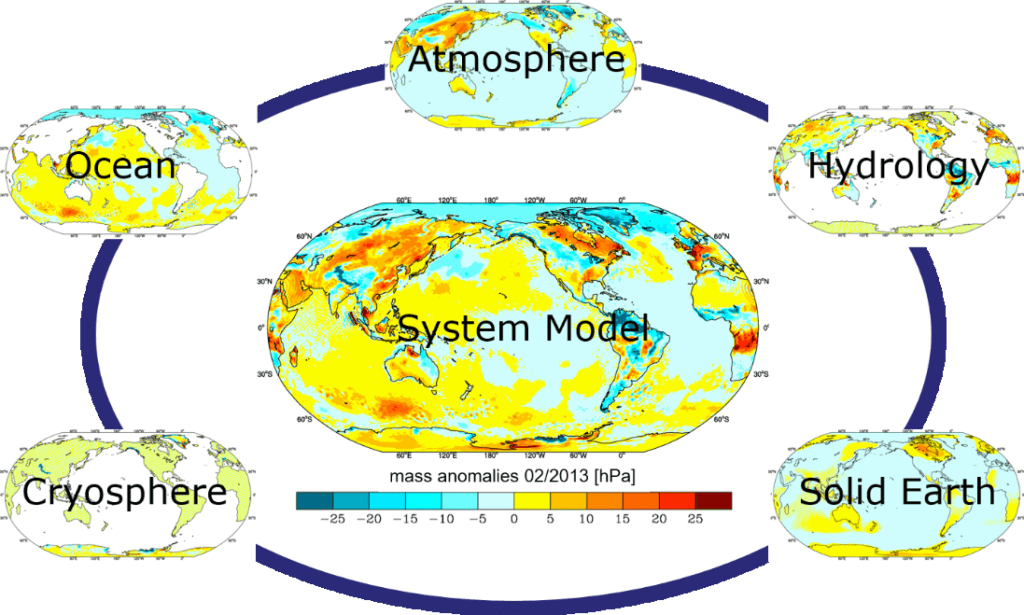BPS – GGOS Committee on
Contribution to Earth System Modelling
Chair: Maik Thomas (GFZ, Germany)
Role
The GGOS Committee on “Earth System Modeling” tends to promote the development of physically consistent modular Earth system modeling tools that are simultaneously applicable to all geodetic parameter types (i.e., Earth rotation, gravity field and surface geometry) and observation techniques. Hereby, the committee contributes to:
- The interpretation of geodetic monitoring data and, thus, to a deeper understanding of processes responsible for the observed variations;
- The establishment of a link between the geodetic products delivered by GGOS and numerical process models;
- A consistent combination and integration of observed geodetic parameters derived from various monitoring systems and techniques;
- The utilization of geodetic products for the interdisciplinary scientific community.
Simulated mass anomalies in a modular system model approach.
Objectives
The overall long-term goal is the development of a physically consistent modular numerical Earth system model for homogeneous processing, interpretation and prediction of geodetic parameters with interfaces allowing the introduction of constraints provided by geodetic time series of global surface processes, rotation parameters and gravity variations. This ultimate goal implicates the following objectives:
- development of Earth system model components considering interactions and relationships between surface deformation, Earth rotation and gravity field variations as well as interactions and physical fluxes between relevant compartments of the Earth system;
- promotion of homogeneous processing of geodetic monitoring data (de-aliasing, reduction) by process modeling to improve analyses of geodetic parameter sets;
- contributions to the interpretation of geodetic parameters derived from different observation techniques by developing strategies to separate underlying physical processes;
- contributions to the integration of geodetic observations based on different techniques in order to promote validation and consistency tests of various geodetic products.
Activities
Current activities focus on:
- the consideration of three-dimensional structures of the Earth’s crust and mantle as well as of anelastic effects in surface mass loading models;
- implementation of interfaces to geodetic monitoring data based on Kalman and particle filter approaches in order to constrain and improve stand-alone model approaches and to prove consistency of various geodetic monitoring products;
- feasibility studies regarding the coupling of neural networks with traditional data assimilation techniques and application of the combined approach in stand-alone models.
Important in-progress activities and future efforts focus on:
- estimation of consequences of upcoming hardware developments for CPU intensive model simulations (high-performance computing vs. exascale modeling);
- application of forward modeling and inversion methods in order to improve model-based predictions of geodetic quantities and to invert geodetic observations for the underlying causative processes.
Selected Publications
- Dill, R., Dobslaw, H., Thomas, M.: ESMGFZ EAM Products for EOP Prediction: Toward the Quantification of Time Variable EAM Forecast Errors. Artificial Satellites, 58, 4, 330-340, 2023.
- Shihora, L., Balidakis, K., Dill, R., Dobslaw, H.: Assessing the stability of AOD1B atmosphere-ocean non-tidal background modelling for climate applications of satellite gravity data: long-term trends and 3-hourly tendencies. Geophysical Journal International, 243, 2, 1063-1072, 2023.
- Dill, R., Dobslaw, H., Thomas, M.: ESMGFZ Products for Earth Rotation Prediction. Artificial Satellites, 57, 254-261, 2022.
- Huang, P., Sulzbach, R., Klemann, V., Tanaka, Y., Dobslaw, H., Martinec, Z., Thomas, M.: The Influence of Sediments, Lithosphere and Upper Mantle (Anelastic) With Lateral Heterogeneity on Ocean Tide Loading and Ocean Tide Dynamics. Journal of Geophysical Research: Solid Earth, 127, 11, e2022JB025200, 2022.
- Schachtschneider, R., Saynisch-Wagner, J., Klemann, V., Bagge, M., Thomas, M.: An approach for constraining mantle viscosities through assimilation of palaeo sea level data into a glacial isostatic adjustment model. Nonlinear Processes in Geophysics, 29, 1, 53-75, 2022.
- Shihora, L., Sulzbach, R., Dobslaw, H., Thomas, M.: Self-attraction and loading feedback on ocean dynamics in both shallow water equations and primitive equations. Ocean Modelling, 169, 101914, 2022.
- Dill, R., Saynisch-Wagner, J., Irrgang, C., Thomas, M.: Improving atmospheric angular momentum forecasts by machine learning. Earth and Space Science, 8, 12, e2021EA002070, 2021.
- Huang, P., Sulzbach, R., Tanaka, Y., Klemann, V., Dobslaw, H., Martinec, Z., Thomas, M.: Anelasticity and lateral heterogeneities in Earth’s upper mantle: impact on surface displacements, self‐attraction and loading and ocean tide dynamics. Journal of Geophysical Research: Solid Earth, 126, 9, e2021JB022332, 2021.
- Sulzbach, R., Thomas, M., Dobslaw, H.: High-Resolution Numerical Modelling of Barotropic Global Ocean Tides for Satellite Gravimetry. Journal of Geophysical Research: Oceans, 126, 5, e2020JC017097, 2021.
- Irrgang, C., Dill, R., Boergens, E., Saynisch-Wagner, J., Thomas, M.: Self-validating deep learning for recovering terrestrial water storage from gravity and altimetry measurements. Geophysical Research Letters, 47, 17, e2020GL089258, 2020.



